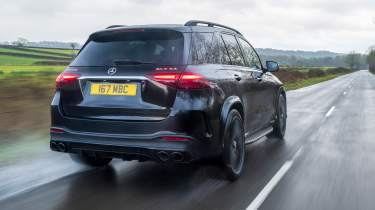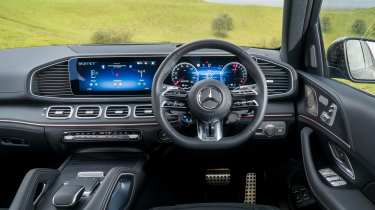Mercedes-AMG GLE 53 Hybrid review – more power, more fun?
Mercedes-AMG’s plug-in hybrid GLE blends refinement and performance into one, but it can’t completely hide its size and weight
A towering, family-sized SUV is never going to be the ultimate driving machine (despite what BMW might tell you), but for years manufacturers have tried their best to make it work. The Mercedes-AMG GLE 53 is one such attempt, sitting between the standard non-AMG lineup and beneath the range-topping V8-powered 63.
Confusingly, there are now two GLE 53 variants on the market: the mild-hybrid GLE 53 and the plug-in hybrid GLE 53 we have here. Cars such as this will never be core evo territory in the way hot hatchbacks, sports cars and trackday weapons might be, but they’re also hard to ignore, mixing practicality, performance and prestige. So what can the AMG GLE 53 offer?
> Mercedes-AMG GT 43 2025 review – £100k four-cylinder lacks Affalterbach soul
Engine, gearbox and technical highlights
As bewildering as its overall lineup might be, the AMG powertrain hierarchy is relatively easy to understand. The ‘53’ models use turbocharged and hybrid-assisted 3-litre straight-sixes, and ‘63’s use that familiar 4-litre twin-turbo V8. The GLE 53 therefore is a GLE powered by the hybrid ‘EQ boost’ in-line six, and in this plug-in hybrid form it produces a fair chunk more power than the mild-hybrid car that came before it.
Power output stands at 529bhp (443bhp coming from the engine at 5800 - 6100rpm), with torque at 553lb ft when combined with electric drive. Unlike in the lesser 429bhp mild-hybrid car, the plug-in hybrid system contributes a sizable uplift in output thanks to the use of a powerful starter generator sandwiched between the engine and transmission.
More reviews
Powering the 48V hybrid system is a 31kWh battery (which can be charged at up to 60kw), allowing for an electric-only range of up to 53 miles (WLTP) according to Mercedes – you’re very unlikely to see this figure in reality. The way most people (including us) will use the car is in hybrid mode, blending between combustion and electric power for optimum efficiency. The result is an average of just over 40mpg in our experience during mixed driving, but once the battery is empty, this will promptly drop to around the 25mpg mark – with the battery ‘dead’, the GLE 53 drives like a mild-hybrid, rolling at low speeds with the engine off.
Where the mild-hybrid car makes do with a 5sec 0-62mph time, this car is three tenths quicker at 4.7sec, with top speed coming at the same 155mph (90mph in electric-only mode). Both cars transfer power to all four wheels via a nine-speed automatic transmission and while the powertrain is refined and well calibrated in most driving scenarios, switching between electric and combustion power seamlessly, there are quirks. Twist the steering wheel-mounted drive mode dial to Sport and the engine fires into life as you’d expect, but for whatever reason it holds revs unusually high (it will do this even if the engine is stone cold). Given the engine sounds tinny and hollow on a cold start, this can be a little embarrassing if you’re not looking to make yourself heard.
Just like the sound it makes, the engine’s character doesn’t suit the car particularly well either – leave the transmission to its own devices and you’ll frequently find yourself sitting at high revs in order to extract the performance it has to offer. While this is a desirable trait in a low slung, manual sports coupe, effortless low end power is something we’ve come to expect in a car of this kind – it seems you have to upgrade to the GLE 63 if you want that. It must be said though, when warm, the engine is very refined and blends into the background well while underway.
Nevertheless, the GLE 53 Hybrid does feel all 529bhp despite its gargantuan weight figure (more on that later), with strong pull from a roll and that nine-speed transmission responsive should you decide to use the paddles – sound might not be a strong point, but you do get satisfying ‘pops’ on upshifts at full throttle.
Performance, ride and handling
Dynamics are better than you’d expect given its size, but it’s certainly not as engaging as a Porsche Cayenne. Which actually, you probably did expect. The thing is, as is often the case for cars of this type, whatever dynamic ability the GLE 53 has will always be compromised somewhat by the physical properties of its kerb weight. In the case of the plug-in hybrid model, it’s a big one. 2725kg DIN to be precise (yes, really), about 400kg more than the mild-hybrid thanks to the addition of that 33kWh battery pack.
AMG has nevertheless got pretty good at minimising those compromises, and there will always be a certain appeal to a vehicle as large as this that performs well and grips hard enough to crack on at a decent pace whatever the road. The GLE 53 is positive and easy to place despite its dimensions and while prioritising refinement means steering feel is lacking, weighting is pleasant. There’s enough precision and grip to make relatively light work of individual turns, allowing you to lean on the outside tyres and in Sport or Sport+ and feed more torque to the rear. This does feel like a car that’s been fettled by AMG and not just one with a new badge.
With some fiddling of driver modes it’s fairly safe to leave the suspension in its firmest set-up too. The GLE rides more than acceptably pretty much everywhere, and loses little compliance in Sport+, but certainly gains in body control, with less float over undulations and a little more response to steering inputs, settling quickly when you turn in rather than rolling – comfort is not as compromised as in most hot SUVs. Quick direction changes still aren’t its forté (it’ll never fully hide its mass) but if your commute includes a few roundabouts it might surprise you.
We’re not keen on the soft brake feel of the mild-hybrid, but this plug-in hybrid car has a much more positive pedal, progressive and easy to modulate – given this car blends strong regenerative braking with friction brakes, this is quite a feat. Chunky 400mm front and 370mm discs will undoubtedly help matters and while we had plenty of confidence in the system during our time in the car, that weight figure is bound to overwhelm them should you push hard for longer periods.
The GLE 53 is more effective than it is entertaining, and the feeling isn’t quite as amusing as a Cayenne, but it’s not lacking in ability. The GLE’s traditional SUV high driving position is also effective – being able to see over uncut verges and hedges is an underrated benefit of cars such as this.
Interior and tech
As with most Mercedes products at this level, the cabin’s a nice place to spend time. MBUX remains one of the more effective infotainment set-ups (with a genuinely usable voice control option that minimises time spent staring at screens) and everything you’re likely to touch feels well put together, with nice weighting to just about everything that moves. There are also a refreshing number of physical buttons for frequently accessed controls which is nice to see – the overall cabin design does feel a tad dated overall, but we don’t have any complaints.
The heated and massaging seats are an exceedingly comfortable place to spend hours on end, with the spacious cabin chock full of tech. Our particular car had features like cooled cup holders, classy Oakwood trim and those trademark AMG steering wheel mounted display dials to make it feel like a no-costs-spared exercise. Oddly our car did come without adaptive cruise control and a heated steering wheel, but this is likely a quirk of an early non-UK spec example and not something UK buyers will experience.
Price, specs and rivals
The Mercedes-AMG GLE 53 now starts at a punchy £94,835, £20,000 more than it did at the beginning of the decade. Nevertheless, this price gets you the more powerful plug-in hybrid car we have here, with the mild-hybrid car costing £1830 more, oddly. As tested, our car was optioned to £101,360, but you could certainly inflate this figure further should you tick enough boxes.
Thankfully for this price you do get an awful lot of kit as standard, with the sliding panoramic sunroof, valve-controlled 'AMG Performance' exhaust system, trick augmented reality navigation and those steering wheel-mounted display dials all no-cost. Opt for the Night Edition Premium Plus (from £101,960) and you get much of the same, just with black trim throughout and uprated 22-inch forged wheels in black to match.
While the GLE 53 seems pricey at its near-£100,000 starting price, all of its closest rivals are more expensive still. Audi, BMW and Porsche all field key alternatives with the SQ7 (£98,540), the X5 M60i xDrive (£99,060) and the Cayenne S E-Hybrid (£95,200). Of the group we’d still pick the Cayenne, with its combination of build quality, refinement and performance the best of the bunch.
Mercedes-AMG GLE 53 Hybrid specs
| Engine | 3-litre twin-turbocharged straight six & electric motor |
| Power | 529bhp combined |
| Torque | 553lb ft |
| Weight | 2725kg DIN |
| Power-to-weight | 194bhp/ton |
| 0-62mph | 4.7sec |
| Top speed | 155mph |
| Basic price | £94,835 |




